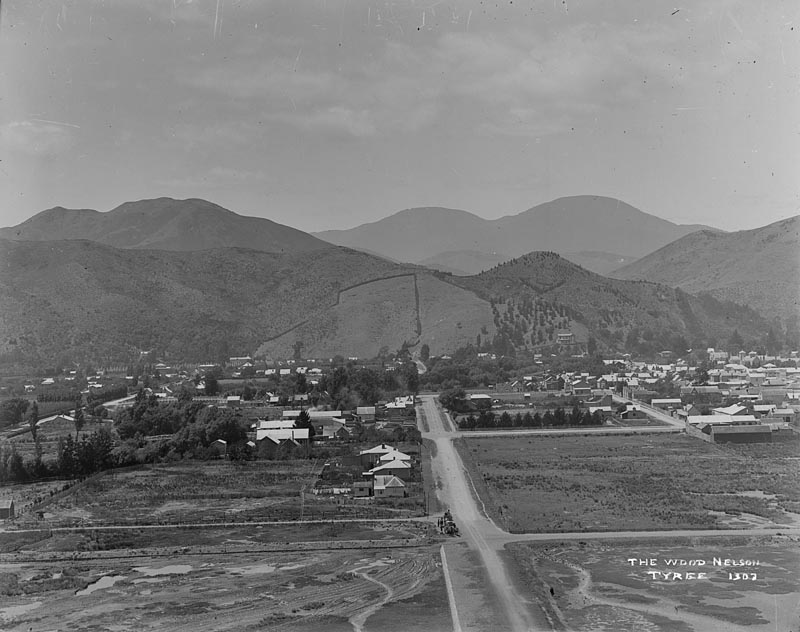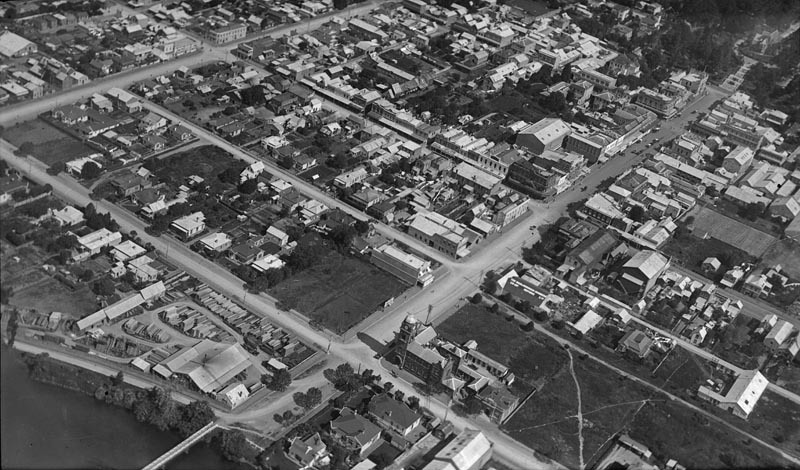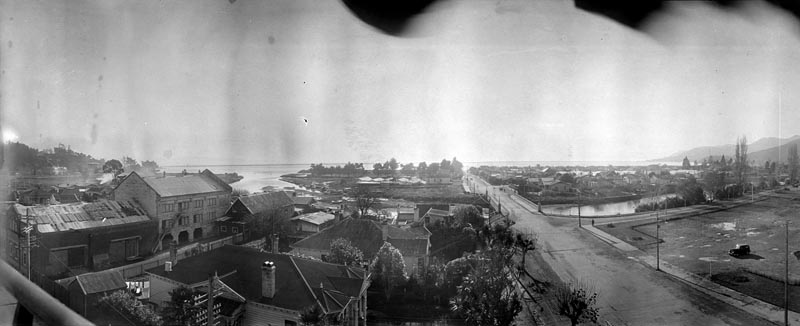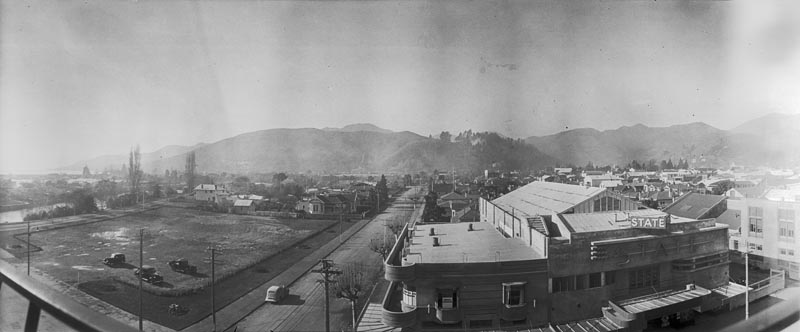Millers Acre or Taha o te Awa
Millers Acre, sits beside the Maitai River and is in the heart of, what is now, Nelson City. It has been put to a number of uses over the years.
Millers Acre, sits beside the Maitai River and is in the heart of, what is now, Nelson City. It has been put to a number of uses over the years.
Early Māori history
The Mahitahi (Maitai) River featured prominently in the lives of past generations of Māori, Ngāti Kuia and Ngāti Tumatakokiri and later others, who lived in and around Whakatū. Seasonal camps for fishing and eeling were sited near the mouth, possibly near what is now Millers Acre. The importance of the Maitai River and its resources to the manawhenua iwi at the time of European settlement is evidenced by the selection of Native Tenths Reserves by the New Zealand Company. The pattern of selection by Nelson magistrate Henry Thompson, during a ballot in 1842, indicates that he was being guided by Māori preferences based on their customary uses. Sections were chosen near the mouth of the river, along both banks of the Maitai and around the tidal edges of the estuary. These selections reflect the importance of the Haven and the river as mahinga kai (food resource).
The name
The fact that a windmill occupied this site from 1853 to 1867 created an assumption that the name Millers Acre derived from this time. In reality, the name surfaced during a public referendum in 1937 to decide whether Nelson City Council should purchase the land from the Andrew Miller Estate, for the building of a municipal centre. Nelsonians voted in favour of purchase and, after 68 years, a centre was built.
The Māori name, Taha o te Awa, was given to the Millers Acre Centre when it opened in 2005 and translates as ‘beside the river'.
Dr Bush's windmill
The Nelson Examiner of 8 January, 18531 noted: "The windmill which has been erected by Mr. Bush at the bottom of Trafalgar Street, was worked for the first time on Saturday last. The building and machinery is most substantial and complete, and besides its utility, the mill is really, from its admirable structure, an ornament to the town."
The owner, Dr. G.F. Bush, had arrived in Nelson in February 1842 as surgeon aboard the New Zealand Company ship, the Lloyds. The voyage, bringing the families of the preliminary expedition men, had been a sorry tale of infant deaths and adult immorality. Dr. Bush and Captain Green were found culpable and received no payment for the voyage, with Bush also fined for each passenger death, leaving him in debt to the Company. Despite the stain on his reputation, Dr. Bush is recorded as practising medicine while farming at Waimea in 1847. After selling his farm in 1849, he began his flour milling enterprise, and was elected as a Town member of the new Provincial Council in 1853. Dr. Bush sold the mill to John Scott before his death in 1863.
John Scott
Following purchase of the windmill from Dr. Bush in 1863, carpenter John Scott used the mill as a workshop. One unfortunate day2, four years later, sparks from an adjacent steam engine shed set the windmill on fire, completely razing it to the ground. During excavations for the Millers Acre centre in 2004, charred timber remains, thought to be of the mill, were unearthed.
John Scott came to Nelson in the late 1850s and was responsible for the construction of a great number of prominent buildings in the town. His first big contract was for the Nelson Provincial Council building in Albion Square, an iconic part of the townscape until its demolition in 1969. A surviving example of his work is Fellworth, above the eastern end of Bridge Street. John Scott was also the contractor for the Nelson to Foxhill railway. Prominent in business circles, he served as a City Councillor and was widely mourned on his death in 1897. The business was subsequently managed by Alfred Clayden.
The Miller family
Andrew Miller served an apprenticeship with John Scott before purchasing a sash and door business in Motueka. In 1906 he bought the Nelson business from John Scott's estate, naming it Miller and Sons. Miller worked as a builder, contractor and timber merchant and also operated sawmills at Pelorus and Kumara. Sawn timber was unloaded from the schooner Orakei at a small wharf he built on the river. The family lived in an adjacent house in Halifax Street. Andrew Miller died in 1926 and the business continued until the site was sold to the Nelson City Council in 1937.
Millers acre
In 1936 City Councillor J Auty Harley proposed that Nelson City Council purchase the site for construction of a civic centre to include a Town Hall, Municipal Offices and Early Settlers Hall. A public referendum approved the idea, and after the 1937 purchase the Council resolved to use the area as a car park until the proposed building went ahead. It was felt that completion of the project would be a fitting observance of the Centenary of European settlement in 1942. The outbreak of World War Two intervened and then escalating costs and the demand for more pressing work put an end to the proposal. The area was tar-sealed in 1962 and the Council opened new offices in Upper Trafalgar Street in 1965. The Public Relations Office moved to Millers Acre in 1973, with its building growing to house the city's Information Centre and, in 1990, the Citizens Advice Bureau moved alongside. The present complex opened in 2005.
The Millers Acre Centre - Taha o te Awa (Nelson Visitor Centre) won the New Zealand Creative Places Award for Built Environment: City and Regional Councils category in 2006. The sculpture on the wall of the building, the Vessel, by local jeweler and sculptor Gavin Hitchings, has also been widely praised.
The view, on the left is taken from the Post Office tower, some time after the opening of the State Cinema in 1936 and the sale of Miller's timber yard to Nelson City Council in 1937. The Miller family home at 41 Halifax Street can be seen adjacent to the cleared yard. Frances Miller, widow of Andrew, was still in residence at this time. The houses to the left belonged to the Greenslade family, former owners of the tannery which operated from the large building at the rear, part of which still stands today.
This information was produced for a Nelson City Council Heritage Panel, 2006, text by Janet Bathgate. Updated 2011 and 2021
Story by: Janet Bathgate for Nelson City Council
Sources
- The Nelson Examiner (1853, January 8) Nelson Examiner and New Zealand Chronicle, p. 182
http://paperspast.natlib.govt.nz/cgi-bin/paperspast?a=d&d=NENZC18530108.2.4 - Another fire in Nelson (1867, September 20), Colonist, p.3
http://paperspast.natlib.govt.nz/cgi-bin/paperspast?a=d&d=TC18670920.2.9
Further Sources
Books
- Allan, R. (1965) Nelson: a history of early settlement. Wellington: A.H. & A.W. Reed
http://www.worldcat.org/oclc/8650658 - Bell, C.W. (1978) unfinished business. Nelson: Nelson City Council, pp. 87, 134
http://www.worldcat.org/oclc/34523816
Newspapers
- Gibbs, P. (2006 Jul/Aug), Architecture New Zealand, 4, pp 60-61
- Remembering the miller of Millers Acre (2005, November 19) Nelson Mail, p.16
- Arts award for Millers Acre (2006, July 18) Nelson Mail, p.3
- More accolades for architects of Millers Acre (2006, September 29) Nelson Mail, p2
- Millers Acres a whirl of history (2005, November 12) Nelson Mail, p.18
Websites
- Visitor's Centre - Nelson i-SITE at Millers Acre Centre, Taha o te awa, Retrieved 17 July 2011 from NCC:
http://www.nelsoncitycouncil.co.nz/millers-acre-centre/
Maps
- Nelson PhotoNews (1966, May 28), no. 67 [image of car park]
https://photonews.org.nz/nelson/issue/NPN67_19660528/t1-body-d31.html - Scott, John 1832-1897 [plans]. Nelson Provincial Museum



